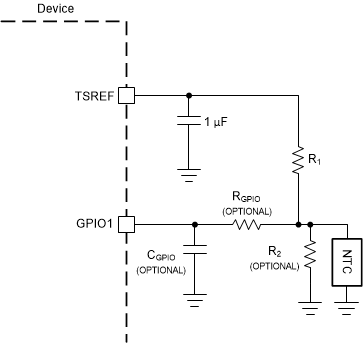ZHCSR27D August 2020 – September 2022 BQ79612-Q1 , BQ79614-Q1 , BQ79616-Q1
PRODUCTION DATA
- 1 特性
- 2 应用
- 3 说明
- 4 Revision History
- 5 说明(续)
- 6 Device Comparison Table
- 7 Pin Configuration and Functions
- 8 Specifications
-
9 Detailed Description
- 9.1 Overview
- 9.2 Functional Block Diagram
- 9.3
Feature Description
- 9.3.1 Power Supplies
- 9.3.2 Measurement System
- 9.3.3 Cell Balancing
- 9.3.4 Integrated Hardware Protectors
- 9.3.5 GPIO Configuration
- 9.3.6
Communication, OTP, Diagnostic Control
- 9.3.6.1
Communication
- 9.3.6.1.1 Serial Interface
- 9.3.6.1.2 Daisy Chain Interface
- 9.3.6.1.3 Start Communication
- 9.3.6.1.4 Communication Timeout
- 9.3.6.1.5 Communication Debug Mode
- 9.3.6.1.6 Multidrop Configuration
- 9.3.6.1.7 SPI Master
- 9.3.6.1.8 SPI Loopback
- 9.3.6.2 Fault Handling
- 9.3.6.3 Nonvolatile Memory
- 9.3.6.4 Diagnostic Control/Status
- 9.3.6.1
Communication
- 9.3.7 Bus Bar Support
- 9.4 Device Functional Modes
- 9.5
Register Maps
- 9.5.1 OTP Shadow Register Summary
- 9.5.2 Read/Write Register Summary
- 9.5.3 Read-Only Register Summary
- 9.5.4
Register Field Descriptions
- 9.5.4.1 Device Addressing Setup
- 9.5.4.2 Device ID and Scratch Pad
- 9.5.4.3
General Configuration and Control
- 9.5.4.3.1 DEV_CONF
- 9.5.4.3.2 ACTIVE_CELL
- 9.5.4.3.3 BBVC_POSN1
- 9.5.4.3.4 BBVC_POSN2
- 9.5.4.3.5 PWR_TRANSIT_CONF
- 9.5.4.3.6 COMM_TIMEOUT_CONF
- 9.5.4.3.7 TX_HOLD_OFF
- 9.5.4.3.8 STACK_RESPONSE
- 9.5.4.3.9 BBP_LOC
- 9.5.4.3.10 COMM_CTRL
- 9.5.4.3.11 CONTROL1
- 9.5.4.3.12 CONTROL2
- 9.5.4.3.13 CUST_CRC_HI
- 9.5.4.3.14 CUST_CRC_LO
- 9.5.4.3.15 CUST_CRC_RSLT_HI
- 9.5.4.3.16 CUST_CRC_RSLT_LO
- 9.5.4.4 Operation Status
- 9.5.4.5 ADC Configuration and Control
- 9.5.4.6
ADC Measurement Results
- 9.5.4.6.1 VCELL16_HI/LO
- 9.5.4.6.2 VCELL15_HI/LO
- 9.5.4.6.3 VCELL14_HI/LO
- 9.5.4.6.4 VCELL13_HI/LO
- 9.5.4.6.5 VCELL12_HI/LO
- 9.5.4.6.6 VCELL11_HI/LO
- 9.5.4.6.7 VCELL10_HI/LO
- 9.5.4.6.8 VCELL9_HI/LO
- 9.5.4.6.9 VCELL8_HI/LO
- 9.5.4.6.10 VCELL7_HI/LO
- 9.5.4.6.11 VCELL6_HI/LO
- 9.5.4.6.12 VCELL5_HI/LO
- 9.5.4.6.13 VCELL4_HI/LO
- 9.5.4.6.14 VCELL3_HI/LO
- 9.5.4.6.15 VCELL2_HI/LO
- 9.5.4.6.16 VCELL1_HI/LO
- 9.5.4.6.17 BUSBAR_HI/LO
- 9.5.4.6.18 TSREF_HI/LO
- 9.5.4.6.19 GPIO1_HI/LO
- 9.5.4.6.20 GPIO2_HI/LO
- 9.5.4.6.21 GPIO3_HI/LO
- 9.5.4.6.22 GPIO4_HI/LO
- 9.5.4.6.23 GPIO5_HI/LO
- 9.5.4.6.24 GPIO6_HI/LO
- 9.5.4.6.25 GPIO7_HI/LO
- 9.5.4.6.26 GPIO8_HI/LO
- 9.5.4.6.27 DIETEMP1_HI/LO
- 9.5.4.6.28 DIETEMP2_HI/LO
- 9.5.4.6.29 AUX_CELL_HI/LO
- 9.5.4.6.30 AUX_GPIO_HI/LO
- 9.5.4.6.31 AUX_BAT_HI/LO
- 9.5.4.6.32 AUX_REFL_HI/LO
- 9.5.4.6.33 AUX_VBG2_HI/LO
- 9.5.4.6.34 AUX_AVAO_REF_HI/LO
- 9.5.4.6.35 AUX_AVDD_REF_HI/LO
- 9.5.4.6.36 AUX_OV_DAC_HI/LO
- 9.5.4.6.37 AUX_UV_DAC_HI/LO
- 9.5.4.6.38 AUX_OT_OTCB_DAC_HI/LO
- 9.5.4.6.39 AUX_UT_DAC_HI/LO
- 9.5.4.6.40 AUX_VCBDONE_DAC_HI/LO
- 9.5.4.6.41 AUX_VCM_HI/LO
- 9.5.4.6.42 REFOVDAC_HI/LO
- 9.5.4.6.43 DIAG_MAIN_HI/LO
- 9.5.4.6.44 DIAG_AUX_HI/LO
- 9.5.4.7 Balancing Configuration, Control and Status
- 9.5.4.8 Protector Configuration and Control
- 9.5.4.9 GPIO Configuration
- 9.5.4.10 SPI Master
- 9.5.4.11 Diagnostic Control
- 9.5.4.12 Fault Configuration and Reset
- 9.5.4.13
Fault Status
- 9.5.4.13.1 FAULT_SUMMARY
- 9.5.4.13.2 FAULT_COMM1
- 9.5.4.13.3 FAULT_COMM2
- 9.5.4.13.4 FAULT_COMM3
- 9.5.4.13.5 FAULT_OTP
- 9.5.4.13.6 FAULT_SYS
- 9.5.4.13.7 FAULT_PROT1
- 9.5.4.13.8 FAULT_PROT2
- 9.5.4.13.9 FAULT_OV1
- 9.5.4.13.10 FAULT_OV2
- 9.5.4.13.11 FAULT_UV1
- 9.5.4.13.12 FAULT_UV2
- 9.5.4.13.13 FAULT_OT
- 9.5.4.13.14 FAULT_UT
- 9.5.4.13.15 FAULT_COMP_GPIO
- 9.5.4.13.16 FAULT_COMP_VCCB1
- 9.5.4.13.17 FAULT_COMP_VCCB2
- 9.5.4.13.18 FAULT_COMP_VCOW1
- 9.5.4.13.19 FAULT_COMP_VCOW2
- 9.5.4.13.20 FAULT_COMP_CBOW1
- 9.5.4.13.21 FAULT_COMP_CBOW2
- 9.5.4.13.22 FAULT_COMP_CBFET1
- 9.5.4.13.23 FAULT_COMP_CBFET2
- 9.5.4.13.24 FAULT_COMP_MISC
- 9.5.4.13.25 FAULT_PWR1
- 9.5.4.13.26 FAULT_PWR2
- 9.5.4.13.27 FAULT_PWR3
- 9.5.4.14
Debug Control and Status
- 9.5.4.14.1 DEBUG_CTRL_UNLOCK
- 9.5.4.14.2 DEBUG_COMM_CTRL1
- 9.5.4.14.3 DEBUG_COMM_CTRL2
- 9.5.4.14.4 DEBUG_COMM_STAT
- 9.5.4.14.5 DEBUG_UART_RC
- 9.5.4.14.6 DEBUG_UART_RR_TR
- 9.5.4.14.7 DEBUG_COMH_BIT
- 9.5.4.14.8 DEBUG_COMH_RC
- 9.5.4.14.9 DEBUG_COMH_RR_TR
- 9.5.4.14.10 DEBUG_COML_BIT
- 9.5.4.14.11 DEBUG_COML_RC
- 9.5.4.14.12 DEBUG_COML_RR_TR
- 9.5.4.14.13 DEBUG_UART_DISCARD
- 9.5.4.14.14 DEBUG_COMH_DISCARD
- 9.5.4.14.15 DEBUG_COML_DISCARD
- 9.5.4.14.16 DEBUG_UART_VALID_HI/LO
- 9.5.4.14.17 DEBUG_COMH_VALID_HI/LO
- 9.5.4.14.18 DEBUG_COML_VALID_HI/LO
- 9.5.4.14.19 DEBUG_OTP_SEC_BLK
- 9.5.4.14.20 DEBUG_OTP_DED_BLK
- 9.5.4.15
OTP Programming Control and Status
- 9.5.4.15.1 OTP_PROG_UNLOCK1A through OTP_PROG_UNLOCK1D
- 9.5.4.15.2 OTP_PROG_UNLOCK2A through OTP_PROG_UNLOCK2D
- 9.5.4.15.3 OTP_PROG_CTRL
- 9.5.4.15.4 OTP_ECC_TEST
- 9.5.4.15.5 OTP_ECC_DATAIN1 through OTP_ECC_DATAIN9
- 9.5.4.15.6 OTP_ECC_DATAOUT1 through OTP_ECC_DATAOUT9
- 9.5.4.15.7 OTP_PROG_STAT
- 9.5.4.15.8 OTP_CUST1_STAT
- 9.5.4.15.9 OTP_CUST2_STAT
-
10Application and Implementation
- 10.1 Application Information
- 10.2
Typical Applications
- 10.2.1
Base
Device Application Circuit
- 10.2.1.1 Design Requirements
- 10.2.1.2 Detailed Design Procedure
- 10.2.1.3 Application Curve
- 10.2.2 Daisy Device Application Circuit
- 10.2.1
Base
Device Application Circuit
- 11Power Supply Recommendations
- 12Layout
- 13Device and Documentation Support
- 14Mechanical, Packaging, and Orderable Information
10.2.1.2.4 GPIO For Thermistor Inputs
When using external thermistor, for ADC measurement only, there is no limitation of what type of thermistors (NTC or PTC) or the bias resistor (R1) value or whether the thermistor is placed on high side or low side with respected to the bias resistor.
However, when using with the integrated OTUT comparators, the programmable OT and UT threshold ranges are designed to work with a 103NTC (10 kΩ at 25°C) type of NTC thermistor, following the connection shown in Figure 10-5 with different options for the R1 and R2 resistors.
- Option 1: R1 = 10 kΩ, and no R2
- Option 2: R1 = 10 kΩ, and R2 = 100 kΩ for better linearity at cold temperature
- Option 3: R1 = 3.6 kΩ, and R2 = 15 kΩ. This base option can be used for NTC used for the OTCB feature assuming system designer allows the PCB temperature to be higher than the cell temperature during balancing. Because the device does not differentiate which NTC is used on the cells versus the PCB, NTC biasing with this option scales the NTC’s hot temperature curve differently, allowing the threshold set for OT comparator to be triggered at a lower GPIO voltage. Thus, making the device to only trigger OTCB threshold on this NTC.
The device does not require external RC for temperature measurement. However, it is common for system designer to add an RC filter on the GPIO pin for the NTC circuit. System designer can select the RC values for the application need. Example: RGPIO = 1 kΩ, CGPIO = 0.1 μF to 1 μF.
Unused GPIO must be grounded to AVSS with a 10-kΩ resistor.
 Figure 10-5 NTC Connection
Figure 10-5 NTC Connection